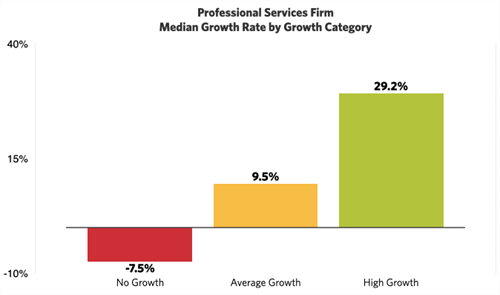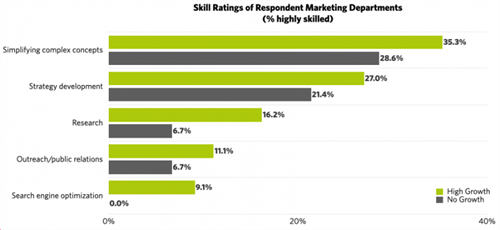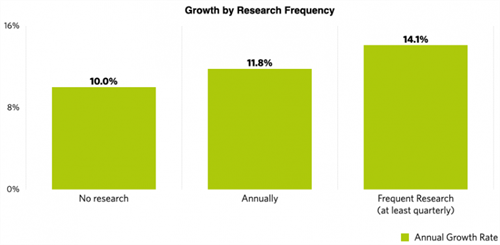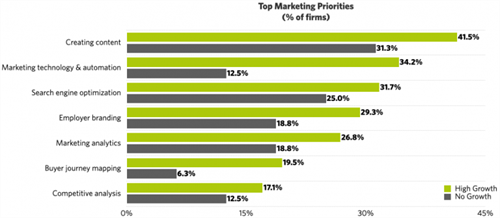Success Tips from the Practices of High-Growth Firms
The accounting and financial services industries have been navigating seas where unforeseen waves can wipe out firms too slow to adjust while keeping agile players afloat. Find out how the fastest-growing firms compare to their average- to slower-growth peers.
 By Lee Frederiksen, PhD
By Lee Frederiksen, PhD
The accounting and financial services industries have been navigating seas where unforeseen waves can wipe out firms too slow to adjust while keeping agile players afloat. In Hinge Research Institute’s 2020 High-Growth Study: Accounting and Financial Services Edition, digital disruption is forecast to deepen the wedge between winners and losers in the years to come. The study looks at more than 200 firms with a combined revenue of over $15 billion and 95,000 professionals. It compares the fastest-growing firms with their average- to slower-growth peers and uncovers the practices that high-growth firms share and set them apart.
The Digital Gatekeeper
Clients with business problems search the internet for solutions, providers of those solutions, and reviews of those providers. They also rule out 90% of firms they’ve never had digital contact with. You may be getting passed over before you can even make a pitch.
This change in buyer behavior should give you pause. If you’re like most accounting and financial services firms, your lead generation and nurturing lags behind that of other professional services firms. Many of these other businesses generate at least two-thirds of their leads through digital assets and social media. We call them Digital Disruptors. By contrast, accounting and financial services are less than half as likely to be Digital Disruptors; in fact, they are much more likely to be laggards.
Growth and Profitability: There Is No Dichotomy
High-growth firms demonstrate how profitability and growth go hand in hand. They grow more than three times faster than average-growth firms. Surprisingly, they are also almost twice as likely to be highly profitable (25% or greater profit as a percent of gross revenue), and less than half as likely to be low profitability (10% or less).

The report’s executive summary offers a cautionary tale on prioritizing profit at the expense of growth; the upshot being that some low growth firms are cutting themselves off at the knees to achieve profitability. Others achieve neither growth nor high profitability.
So, what do the high-growth firms do differently? They have better access to relevant skills.
Talent Acquisition
To succeed in the digital age, you must have the right mix of talents. High-growth firms have higher levels of such marketing skills as research, public relations/outreach, and search engine optimization (SEO) – many of which are crucial to gaining visibility online.

High-growth firms also excel in communicating complex ideas in ways that audiences quickly grasp. In short, high-growth firms do a better job of educating their audience to sell their expertise to them – online and offline.
There are three ways to access the skills you need: train existing staff, hire new people, and outsource projects or activities. Most firms do all three. They keep skills for day-to-day activities in house, then outsource the rest, such as occasionally used or highly specialized skillsets like SEO and digital marketing strategy.
Eyeing Your Target
Knowing your audience will pay enormous dividends. Firms that conduct frequent research on their target audiences grow faster. Occasional research accelerates growth, but research done at least quarterly is linked to over 40% faster growth.

Firms with accurate and current data on their audiences’ challenges and priorities have a significant competitive advantage over those that don’t because they are able to serve those audiences better.
Also, firms with original research on their target audience can meet the latter’s growing appetite for information on industry trends and insights. Original research serves as the core of an effective content marketing program by demonstrating your familiarity with their industry and expertise in solving their problems.
Think in the Future Tense
High-growth firms’ marketing priorities are different from those of their no-growth peers.
First, they are much more likely to run an effective content marketing program that includes content creation, SEO, and marketing analytics. Second, they pay more attention to their brand, which helps them attract and retain top talent. Finally, they are significantly quicker to embrace marketing automation and buyer journey mapping to reach and serve their audiences, as well as to stay relevant in an evolving marketplace.

When markets change, so too must marketing strategies.
The COVID-19 pandemic ushered in a wave of change that will leave in its wake an industry that looks nothing like what we’ve seen before. Learn from the firms that manage to grow fast amid uncertainty and are likelier than most to emerge from the crisis intact. If you haven’t made the changes by now, then when?
Lee Frederiksen, PhD, is managing partner of Hinge in Reston, Va. He can be reached at lfrederiksen@hingemarketing.com.
Sign up for weekly professional and technical updates in PICPA's blogs, podcasts, and discussion board topics by completing this form.
PICPA Staff Contributors
Disclaimer
Statements of fact and opinion are the authors’ responsibility alone and do not imply an opinion on the part of PICPA officers or members. The information contained in herein does not constitute accounting, legal, or professional advice. For professional advice, please engage or consult a qualified professional.






